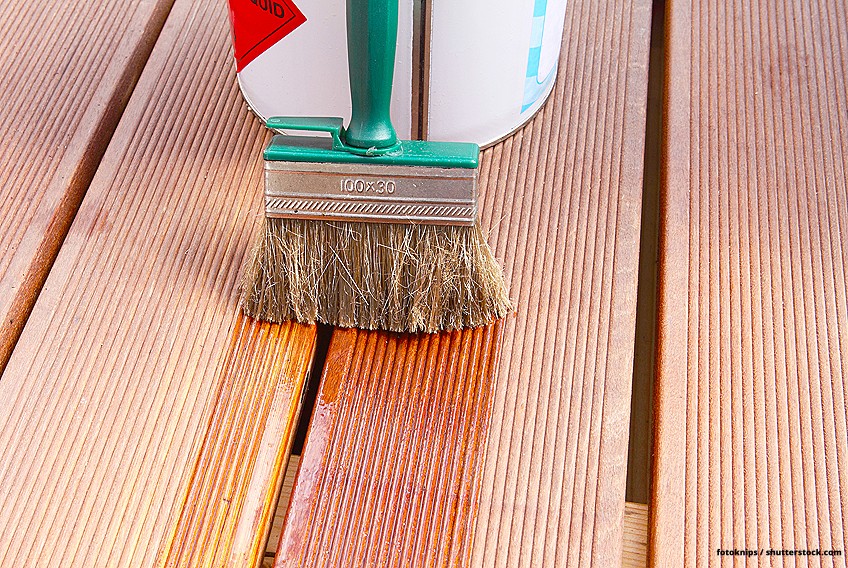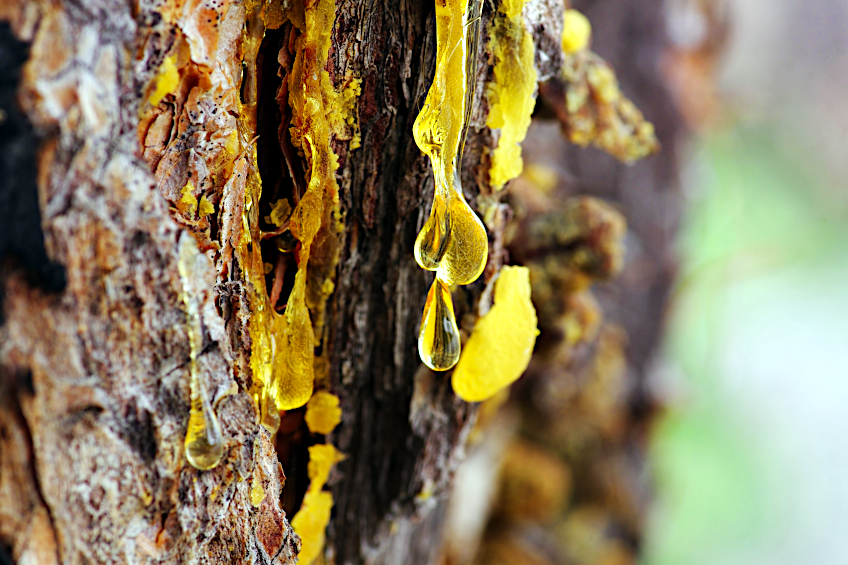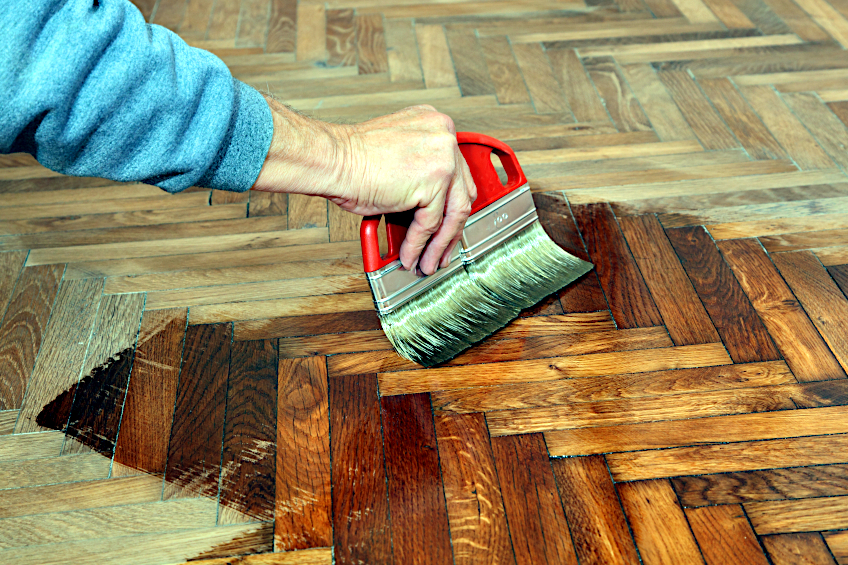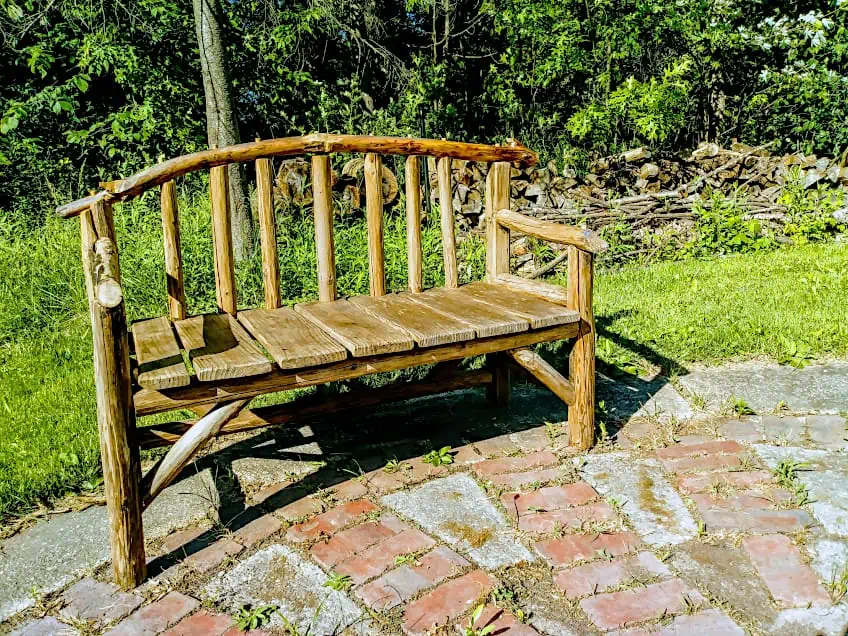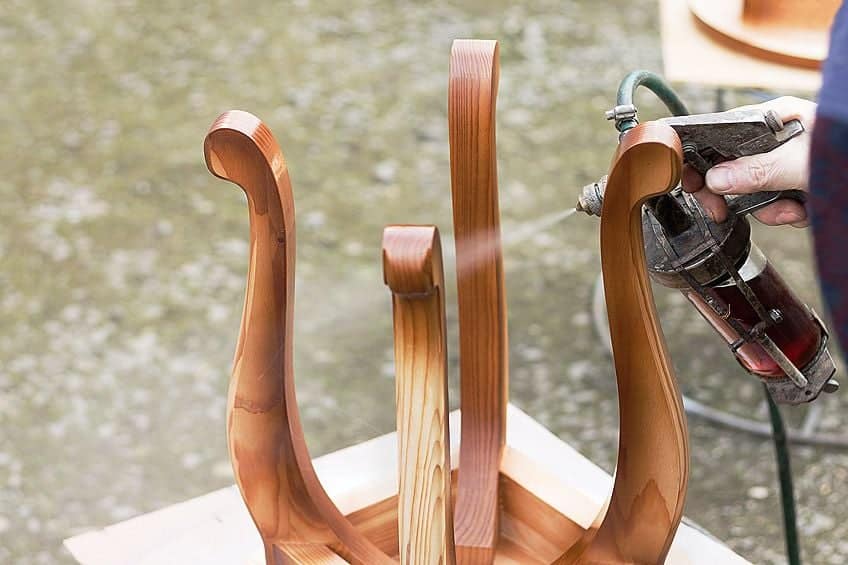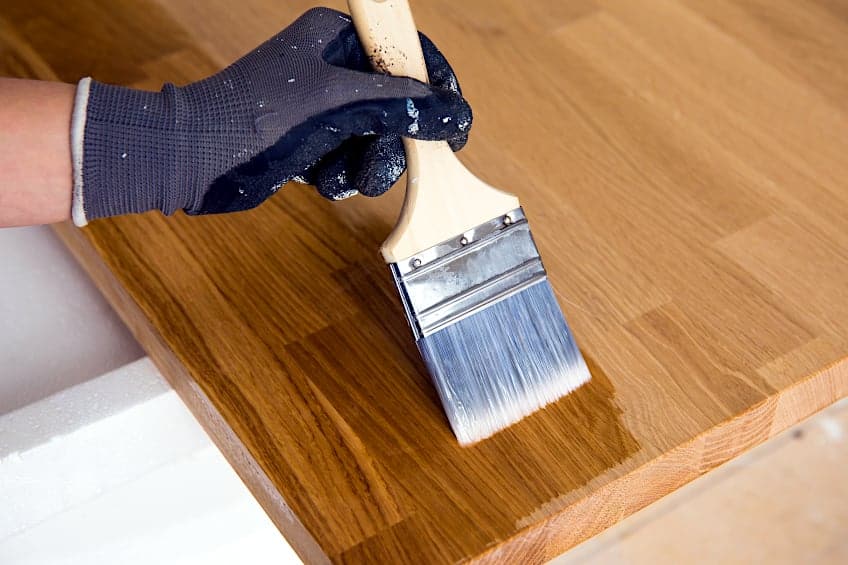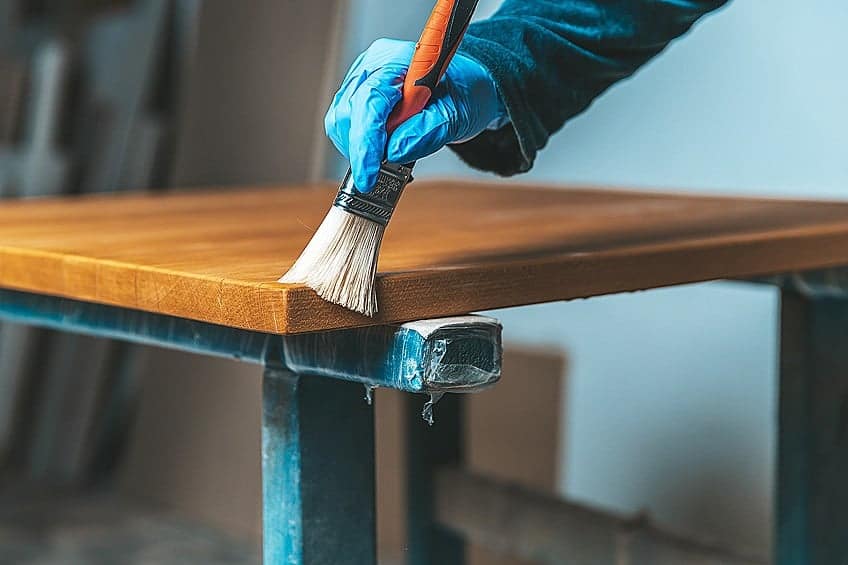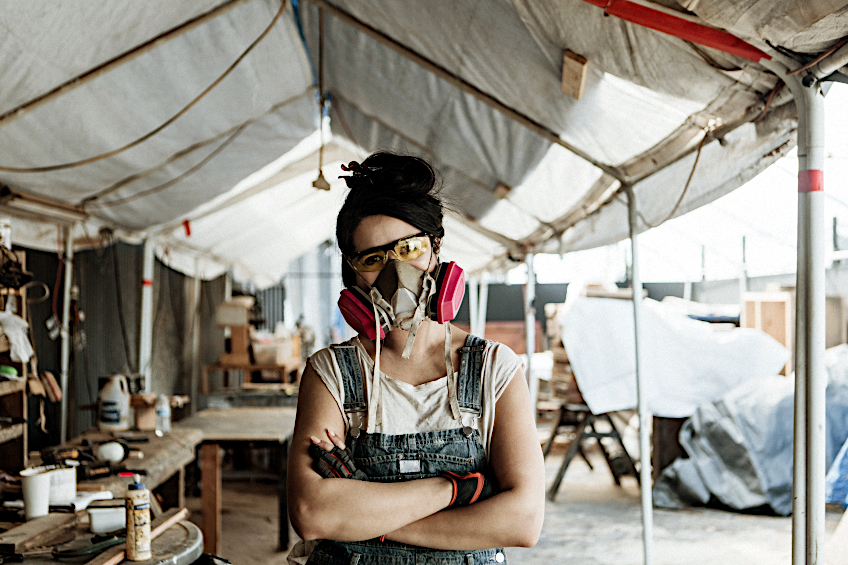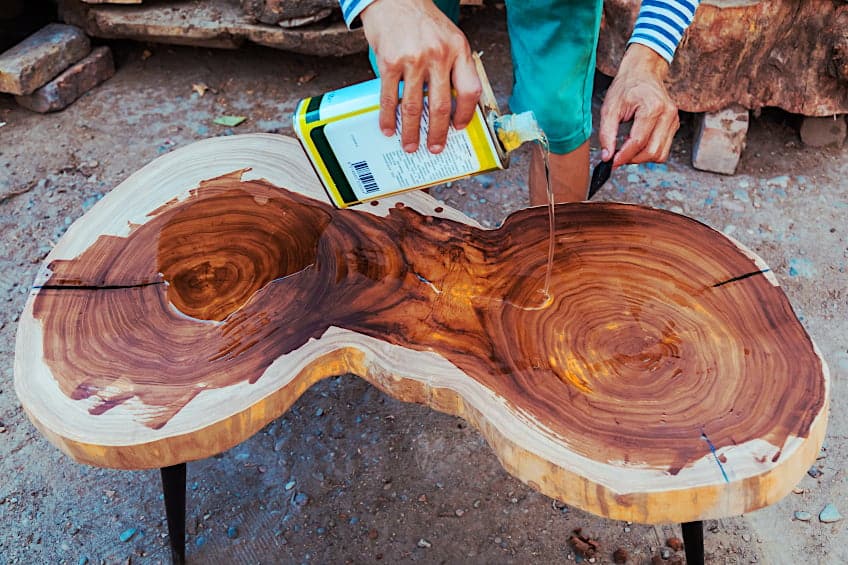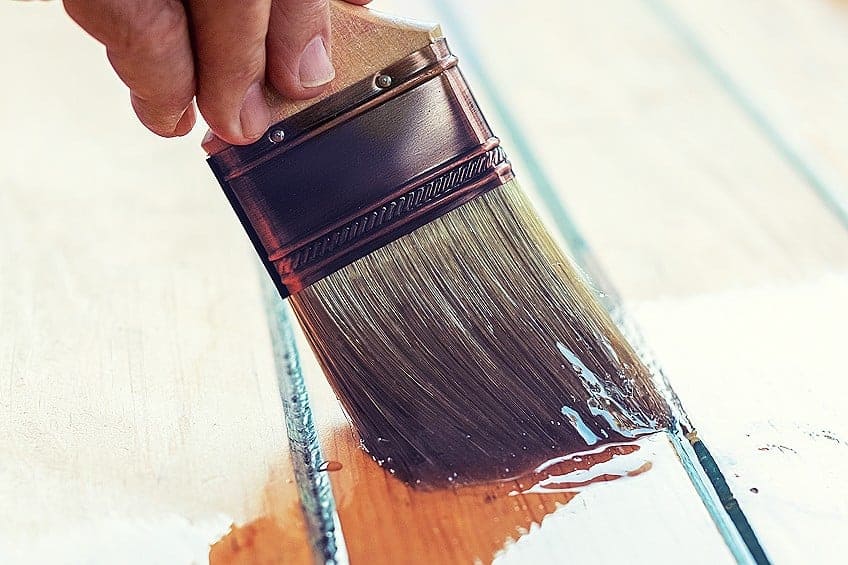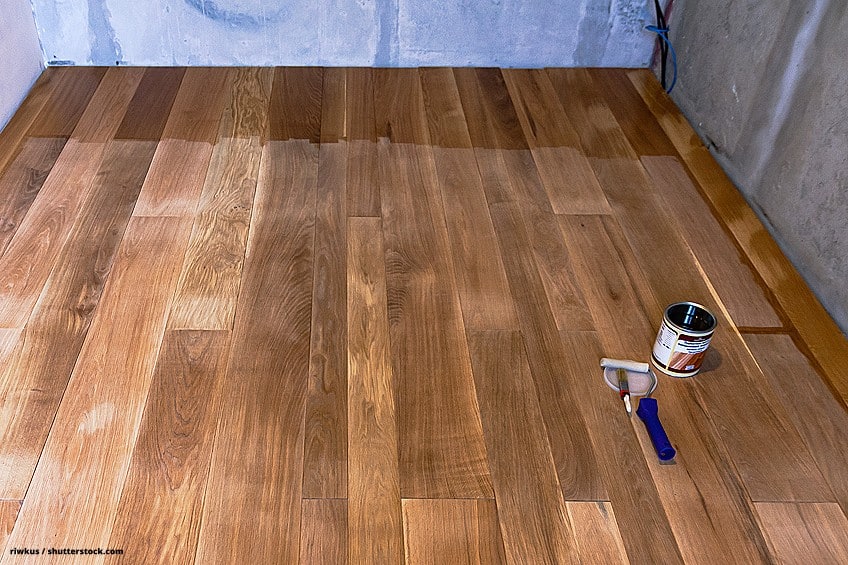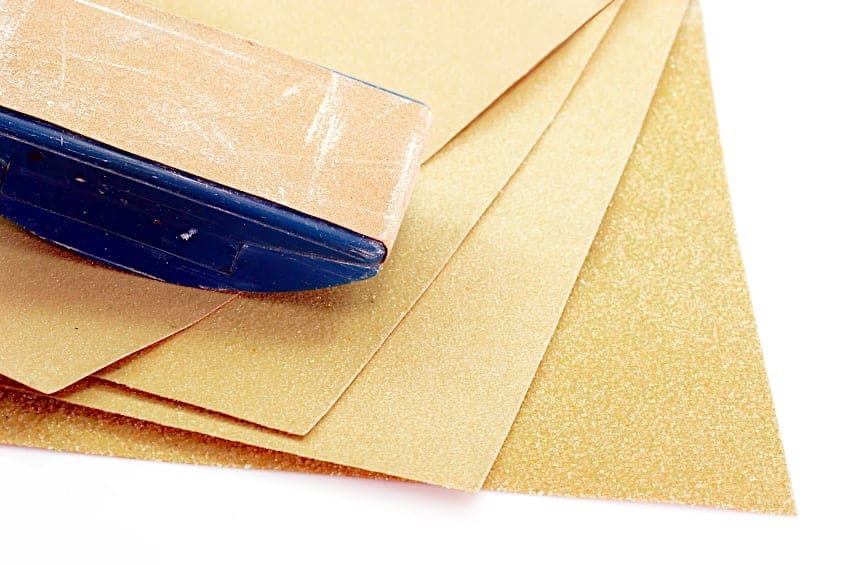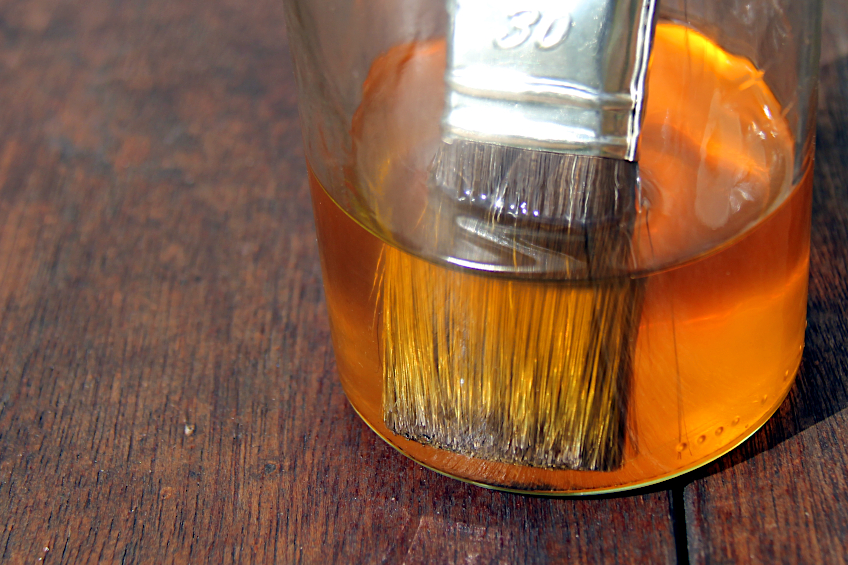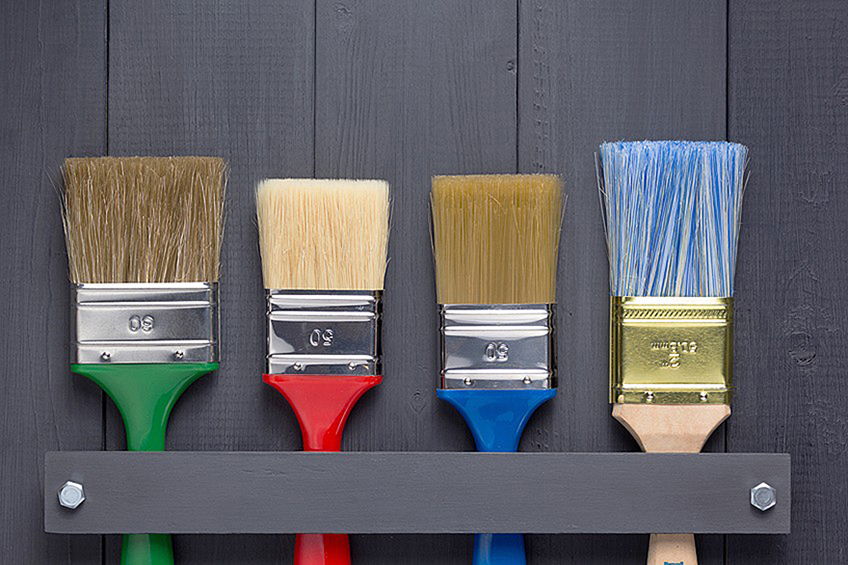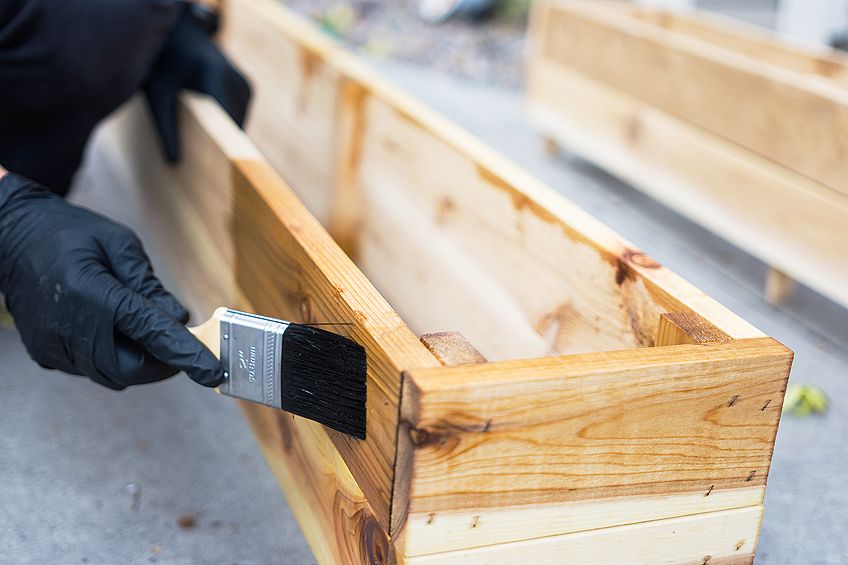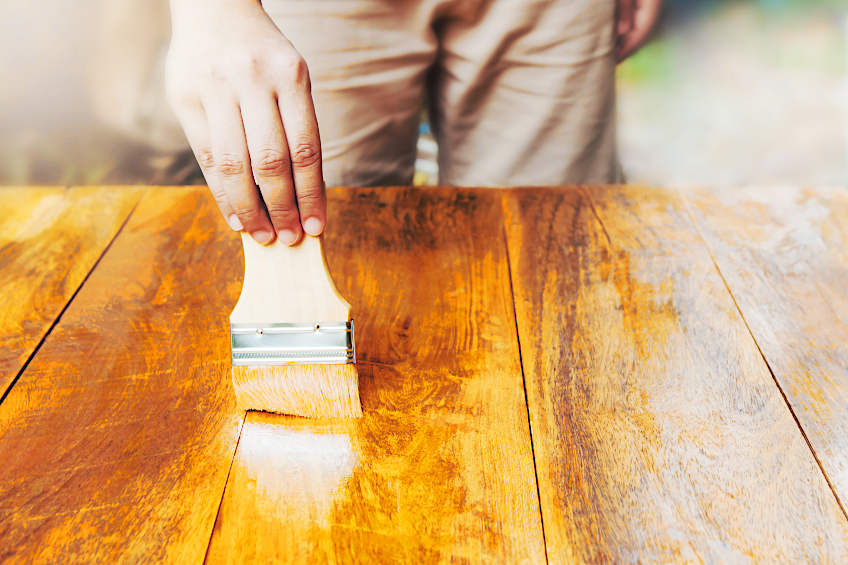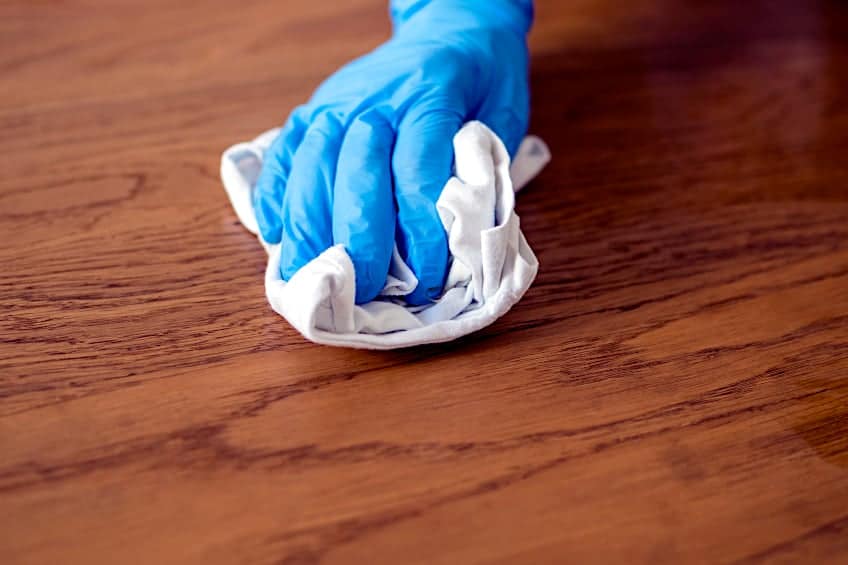What Is Varnish? – Our Guide to Protective Surface Treatments
This post may contain affiliate links. We may earn a small commission from purchases made through them, at no additional cost to you. You help to support resin-expert.com
These days, there are so many options when it comes to finishing a wooden workpiece. Gone are the days when you had to crush up some berries and smear them on your wooden creations to set them apart from your neighbors. These days you have many options, from oil-based paints, latex-based paints, acrylic-based paints, and even metalized paint to choose from when selecting a finish. One of the most tried and true ways to finish a wooden workpiece without sacrificing the grain and texture of your wood is to use wood treatments like wood stain and varnish. So, let’s have a look at what varnish is, why it’s so popular, what it’s used for, what it is made of, and what the best way to use it is.
Table of Contents
What Is Varnish?
What is varnish? The term varnish is often used as a blanket statement for all manner of wood treatments like lacquer or polyurethane-based wood treatments that kind of interact with wood in the same way that real varnish does. This is why it’s often confused with real varnish, which is entirely unique in its composition and the characteristics it grants wood.
What varnish is in a technical sense has changed over the years, and considering that it’s been around for hundreds of years, it is now completely different from what our ancestors knew as varnish. Before, varnish was a term used to describe a wood treatment consisting primarily of wood sap and alcohol, but these days, varnish is a varying mixture of solvents, resins, and oils that are used to treat and seal the wood.
The exact composition of varnish can be altered to achieve a particular look or even work with a specific species of wood, which means that there is no textbook definition of varnish apart from it containing some combination of the aforementioned chemicals in varying quantities. Wood varnish is also inexpensive and highly effective as a means to seal and treat wood aesthetically.
While wood varnish isn’t exactly unique in what it does these days, back in the day it was one of the only ways to ensure that your wood was protected from the elements and looked good at that. This is because even today, varnish interacts with wood in a unique way, seeping deep into the wood’s fibers both altering its colors and sealing it.
What Is Varnished Used For?
What is varnish used for? Well, as we mentioned previously varnish is used to seal and treat wood aesthetically. Usually, it’s used to treat wood that will be situated in an environment that will have it exposed to things like heat, moisture, impact, and abrasion. Varnish works by engaging in a chemical reaction with the internal fibers of the wood, usually by darkening its hue and sealing it.
This makes it more challenging for things like water and insects to enter the wood, which can cause things like rot, mold, and an overall degradation in the wood. Furthermore, varnish also tends to repel moisture really well, which is great for small furnishings like coffee tables, bedside tables, and even wooden coasters which can come into contact with water, soft drinks, tea, and coffee often.
What does varnish do for the longevity of your wood? When you’re choosing a way to finish off your wooden workpiece, you could choose surface coatings like paint or polyurethane, the latter of which can be characterized as both a surface coating and a wood treatment, or you could choose wood treatments like varnish, which don’t just protect the exterior of your wood but the internal wood particles too.
What does varnish do for the aesthetic of your wood? Well, there are many ways for you to improve the look of a wooden workpiece, you could use pyrography, paint, stickers, wrapping, or you could choose wood treatment like stain and/or varnish. The latter not only improves the look of your wooden workpiece but it doesn’t obscure the grain of the wood and preserves its natural texture, which is ideal if you want to show off the wood species you’ve chosen.
Are There Different Types of Varnish?
We mentioned previously that there are many variations of varnish since the term is used to describe basically any wood treatment these days, but there are different types of varnish that have been designed to work in particular applications. This being said, let’s have a look at some of the types of varnish you could use when treating your workpiece for different applications.
Acrylic Varnish
Acrylic varnish is a really cool modern variation of varnish that has all of the advantages of conventional varnish without most of the drawbacks associated with it. Unlike ordinary varnish, the acrylic varnish is water-based and is clear in appearance, it also doesn’t yellow when exposed to natural or artificial light, which is probably why it’s used to protect paintings and crafts as an alternative to epoxy resin or similar clear coat substances.
Spar Varnish
Spar varnish has actually been around for a long time, and if you don’t know what it is it’s probably because you’re not well acquainted with boating or sea faring in general. A spar is essentially a mast on a boat that supports the sail, and back in the day, these were varnished to protect them from the elements. Varnish in those days needed to be re-applied regularly, but modern spar varnish is highly resistant to impact, abrasion, and the effects of prolonged exposure to sunlight and wind.
Alkyd Varnish
Alkyd varnish is one of the most versatile varnish variations out there. This varnish can be used for both interior and exterior furnishings as it doesn’t contain loads of volatile organic compounds (VOCs). Besides being graded for both indoor and outdoor use, alkyd varnish dries quickly and offers great protection from UV damage. What is alkyd varnish made of? Alkyd varnish is made from polyester resins, some fatty acids, and alkyd resins which make it an incredibly durable wood treatment.
Bituminous Varnish
Another type of varnish that has proven to be versatile and hard-wearing is the bituminous variety. This varnish is known for its dark black color which sets it apart from other varnish types which are usually a shade of yellow or completely transparent in appearance. Bituminous varnish is any type of varnish that has had the actual varnish replaced with bitumen which is a hydrocarbon consisting of a petroleum base.
Spirit Varnish
Exterior varnish is pretty much the same thing as spar varnish, except that it has been modernized and refined to be far more durable and resistant to things like impact, abrasion, UV damage, and buffing from wind and sand. Exterior varnish is also known as spar urethane varnish because of its durability, and while it is pretty versatile and hard-wearing, it’s not great for time-sensitive workpieces as it’s fairly slow to dry.
Exterior Varnish
Exterior varnish is pretty much the same thing as spar varnish, except that it has been modernized and refined to be far more durable and resistant to things like impact, abrasion, UV damage, and buffing from wind and sand. Exterior varnish is also known as spar urethane varnish because of its durability, and while it is pretty versatile and hard-wearing, it’s not great for time-sensitive workpieces as it’s fairly slow to dry.
Oil Varnish
Oil-based varnish is widely considered to be true varnish, but this is up for debate. Why is oil varnished considered to be true varnish? Well, it’s as close to the original idea of varnish as you get these days. Oil-based varnish is characterized as having a mix of drying oil and resin without the presence of any solvent. While this means it doesn’t dry as quickly as some other varnish variants, it does longer and offers a better layer of protection compared to faster drying alternatives.
Is Wood Varnish Safe to Use?
One could argue that safety is relative but keeping oneself in objectively good health is something you shouldn’t compromise on. This being said, varnish contains chemicals that can cause serious harm to both your skin and your respiratory system, this is why you should always practice extreme caution when working with varnish.
What can you do to ensure that you’re safe when you’re working with varnish? Well, the best way to go about it is to wear a face mask to protect your airways from the harmful fumes produced by the varnish, and gloves to protect your digits. You should also do your best to work in a well-ventilated area, or outdoors if you can help it.
The wood varnish contains volatile organic chemicals which do a really good job of treating wood, but they aren’t very good for you or the environment in general. This is why most new wood varnish variations contain more sustainably produced chemicals that have little to no impact on the environment.
If you’re concerned about your environmental impact, there are many alternatives to conventional varnish for you to choose from. You could opt for things like wood stain, which doesn’t contain any VOCs in some instances, or you could use completely natural wood treatments like tung oil or linseed oil which take some more maintenance but can be used free of consequence.
Varnish vs. Polyurethane
Choosing between varnish and polyurethane can be tough considering they’re both really durable, adorable, and do a good job of making wood workpieces look good. That being said, there are a few things that you should know about both varnish and polyurethane that will help you choose between the two if you’re having a difficult time deciding.
Varnish and polyurethane are similar, but there are some key differences between the two. Polyurethane is essentially a synthetic alternative to varnish which consists of a type of liquid plastic combined with resin. Polyurethane is sold in both oil-based and water-based forms, with the water-based being more environmentally friendly and fast drying, but not as durable.
Oil-based polyurethane wood treatment is far more durable than the water-based variation, and it seeps into the wood fibers to provide both internal and external protection. That being said, even though oil-based polyurethane is more durable than the water-based alternative it contains loads of VOCs which aren’t great for the environment or your health.
Varnish on the other hand is objectively superior to both water-based and oil-based polyurethane coatings. This is because varnish has more solids present in its composition, which makes it far more resistant to the effects of moisture and prolonged exposure to direct sunlight. It should come as no surprise then that varnish is used to treat furniture and other wooden workpieces that will be spending most of their time outdoors.
While varnish might be better as a protective coating than polyurethane is, it’s not great for use indoors thanks to the presence of VOCs in its makeup. That is why polyurethane coatings of both the water and oil-based variety are used more often indoors than varnish is, plus polyurethane coatings are better suited to handle foot traffic and constant contact which is why they’re often used to coat wood tables and flooring.
How to Varnish Wood
Knowing what varnish is and the different types of varnish that are available to you is all well and good, but if you don’t know how to use it to treat your workpiece, it won’t do you much good. This is why we have prepared a short tutorial detailing how to varnish wood workpieces, as well as some pointers to keep in mind when handling varnish.
Prepare Your Workspace
Regardless of what your project is, when you’re working with varnish it’s important to have your workspace adequately prepared. How do you prepare your workspace for working with varnish you ask? Well, you can start off by ensuring that none of your surfaces accidentally get any varnish on them. Lay down a tarp or some old newspaper on your work surface and on your floor immediately surrounding it.
When it comes to protecting yourself, you will need to take some more steps. Remember that varnish can affect both your skin and your respiratory system so you should gear up accordingly. In order to protect your hands, you should use gloves graded for use with solvents and oils, and to protect your airways you should wear a face mask or respirator.
Prepare Your Workpiece
When working with a wooden workpiece, it’s important to prepare the surface for the treatment process. More often than not, wood has an existing finish or similarly smooth layer such as laminate protecting the surface of the wood. Applying varnish to these surfaces without preparing them can yield poor results, so let’s have a look at how to prepare your surface for varnishing.
The best way to prepare a wooden surface for wood treatments like varnish is to sand the surface well. Sanding the surface ensures that there is enough exposed wood for the varnish to seep in and bond with the wood fibers. It also provides a bunch of surface friction, so the varnish doesn’t just run off onto your floor and shoes. Once you’re done sanding, ensure that you use a clean cloth or some compressed air (or a vacuum) to remove any wood particles, so they don’t get stuck in your varnish.
Thin Out Your Varnish
With most varnish, it’s easier to apply your initial coat if your varnish has been thinned out a little bit. Varnish is a bit thick in its consistency so applying it to your surface as-is can result in bubbles forming on the surface of your workpiece. This process also helps you to prevent runs on the surface of your workpiece, so it’s better to be safe than sorry when it comes to thinning out your varnish.
How do you thin out varnish, you ask? All that you need to do is get your hands on a clean, disposable container, and pour some varnish out into it. Next, you’ll need to get some mineral spirits and throw some into the container. How much, you ask? Around 20% of the total amount of varnish in the container should do the trick. Once you have your ratio, mix the substances together until it is appropriately thinned out.
Apply Your Varnish to Your Workpiece
When applying varnish to the surface of your workpiece, you should use a brush with natural bristles. If you don’t have one, a brush with a medium width will work just as well. Applying varnish is a bit different from applying paint, when applying paint, you’d usually follow the grain and length of the board, but when working with varnish you start against the grain first.
Why? This helps the varnish seep into the wood grain and the fibers underneath. Once you’ve covered the surface painting against the grain, go over it once more but this time following the direction of the grain. This seals the initial coat into the wood, just be sure to let each coat you apply set and dry for the manufacturer’s recommended time period before moving on to the next step.
Apply Your Second Coat
While you don’t need to apply a second coat of varnish to your workpiece, it can help a lot. Two coats of varnish ensure that the surface of your workpiece will last longer and that the seal you’ve created inside the wood is more durable too. Keep in mind that you should only apply your second coat if your first one has had a chance to dry completely.
Your second coat of varnish doesn’t need to be thinned out either, so be sure to compensate for the thicker consistency by using a bit less varnish on your brush this time around. You can apply your varnish by following the grain of the wood this time around and remember to allow your final coat to dry completely just as you did with the first.
How Do You Look After Varnished Surfaces?
Another advantage of using varnish as the surface coating for your wooden workpieces is that it’s pretty easy to maintain. Unlike paint or other wood treatments like tung and linseed oil, varnish does not chip or break as easily and is a lot easier to maintain compared to the aforementioned too. This being said, it’s a pretty good choice for a primary wood coating.
All that you need to do to clean your varnished workpieces is to wipe them down occasionally with a damp cloth. For more stubborn stains, you can use a small amount of soap and a damp cloth to lightly scrub away the stain. Just be sure not to overdo it or you’ll have to repair the spot you’ve scrubbed away.
How Do You Replace Varnish That Has Faded?
Wondering how to deal with a varnish that has faded over the years? Well, although varnish is pretty durable and doesn’t require a lot of maintenance it’s not infallible to damage. Varnish can deteriorate over time, and the best way to repair varnish coatings is to replace them entirely. While it is possible to patch certain areas, this doesn’t always work.
You could apply another coat of varnish over your existing one, but it most likely will turn out a bit patchy. The best thing to do is replace the existing finish completely by sanding the surface of your workpiece and then adding a new one. Ensure that your workpiece is clear of any wood and varnish particles before adding the next one though.
Now that you know what varnish is, what different types of varnishes are available to you, what the difference between varnish and polyurethane is, and how to use your varnish effectively, it’s time for you to get out there and put your newfound knowledge to the test. Remember to maintain your varnished surfaces well and to remove existing finishes completely when restoring your workpiece.
Frequently Asked Questions
What Is Varnish Made Of?
What is varnish made of? There are different types of varnish for different applications. The most commonly used type of varnish is the oil-based kind, which consists of a combination of resin and drying oil. Some variations contain colorants and/or dyes too.
Is Varnished Wood More Durable?
Is varnished wood more durable? Varnished wood is more durable than natural wood, which should come as no surprise considering that varnish is designed to make wood more durable. Varnish protects wood from light impact, abrasion, moisture, and rot.
Is Varnishing Difficult?
Varnishing can be challenging if you’ve never done it before, but the learning curve isn’t that steep. There are many techniques you can use to varnish wood; you can use a brush or you use a cloth to apply your varnish but just ensure that you work in a well-ventilated area.


